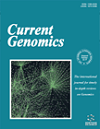- Home
- A-Z Publications
- Current Genomics
- Previous Issues
- Volume 13, Issue 6, 2012
Current Genomics - Volume 13, Issue 6, 2012
Volume 13, Issue 6, 2012
-
-
Differences in Phosphorylated Histone H2AX Foci Formation and Removal of Cells Exposed to Low and High Linear Energy Transfer Radiation
More LessAuthors: Thomas Ernst Schmid, Olga. Zlobinskaya and Gabriele MulthoffThe use of particle ion beams in cancer radiotherapy has a long history. Today, beams of protons or heavy ions, predominantly carbon ions, can be accelerated to precisely calculated energies which can be accurately targeted to tumors. This particle therapy works by damaging the DNA of tissue cells, ultimately causing their death. Among the different types of DNA lesions, the formation of DNA double strand breaks is consi Read More
-
-
-
Clinical, Molecular- and Cytogenetic Analysis of a Case of Severe Radio- Sensitivity
More LessAuthors: K.M. Greulich-Bode, F. Zimmermann, W.-U. Muller, B. Pakisch, M. Molls and F. WurschmidtIn radiotherapy the normal tissue reaction is often a limiting factor for radiation treatment. Still there is no screening method, which predicts normal tissue reaction on radiotherapy, especially in comparison to tumor tissue, and therefore allows tailoring of the radiation dose to each patient. Here, we present a case of severe radiation-related side effects. We applied classical cytogenetic techniques (Giemsa-banding a Read More
-
-
-
Secondary Radiation-Induced Bone Tumours Demonstrate a High Degree of Genomic Instability Predictive of a Poor Prognosis
More LessSecondary bone tumours arising in the field of a preceding radiotherapy are a serious late effect, in particular considering the increasing survival times in patients treated for paediatric malignancies. In general, therapy associated tumours are known to show a more aggressive behaviour and a limited response to chemotherapy compared with their primary counterparts. It is not clear however whether this less favourable outc Read More
-
-
-
Bioinformatic Tools Identify Chromosome-Specific DNA Probes and Facilitate Risk Assessment by Detecting Aneusomies in Extra-embryonic Tissues
More LessDespite their non-diseased nature, healthy human tissues may show a surprisingly large fraction of aneusomic or aneuploid cells. We have shown previously that hybridization of three to six non-isotopically labeled, chromosomespecific DNA probes reveals different proportions of aneuploid cells in individual compartments of the human placenta and the uterine wall. Using fluorescence in situ hybridization, we found that hum Read More
-
-
-
Current Genomics in Cardiovascular Medicine
More LessAuthors: Vinit Sawhney, Scott Brouilette, Dominic Abrams, Richard Schilling and Benjamin O'BrienCardiovascular disease (CVD) is a heterogeneous, complex trait that has a major impact on human morbidity and mortality. Common genetic variation may predispose to common forms of CVD in the community, and rare genetic conditions provide unique pathogenetic insights into these diseases. With the advent of the Human Genome Project and the genomic era, new tools and methodologies have revolutionised the fiel Read More
-
-
-
Preimplantation Genetic Diagnosis for Aneuploidy and Translocations Using Array Comparative Genomic Hybridization
More LessAt least 50% of human embryos are abnormal, and that increases to 80% in women 40 years or older. These abnormalities result in low implantation rates in embryos transferred during in vitro fertilization procedures, from 30% in women <35 years to 6% in women 40 years or older. Thus selecting normal embryos for transfer should improve pregnancy results. The genetic analysis of embryos is called Preimplantation Read More
-
-
-
On the Power of Additional and Complex Chromosomal Aberrations in CML
More LessAuthors: Karin M. Greulich-Bode and Barbara HeinzeUnregulated proliferation of mainly myeloid bone marrow cells and genetic changes in the hematopoietic stem cell system are important features in Chronic Myeloid Leukemia (CML). In clinical diagnosis of CML, classical banding techniques, fluorescence in situ hybridization (FISH) probing for the Philadelphia chromosome (Ph) or polymerase chain reaction amplifying the fusion products of the BCR-ABL fusion are state of the ar Read More
-
-
-
Single Cell Genomics of the Brain: Focus on Neuronal Diversity and Neuropsychiatric Diseases
More LessAuthors: Ivan Y Iourov, Svetlana G Vorsanova and Yuri B YurovSingle cell genomics has made increasingly significant contributions to our understanding of the role that somatic genome variations play in human neuronal diversity and brain diseases. Studying intercellular genome and epigenome variations has provided new clues to the delineation of molecular mechanisms that regulate development, function and plasticity of the human central nervous system (CNS). It has been show Read More
-
-
-
Characterization of the Early CNS Stress Biomarkers and Profiles Associated with Neuropsychiatric Diseases
More LessAuthors: X. R. Lowe and A. J. WyrobekNeuropsychiatric disorders (including dementia) have high personal, family, and social costs. Although many neuropsychiatric disorders share common patterns of symptoms and treatments, there are no validated biomarkers that define the underlying molecular mechanisms in the central nervous system (CNS). We hypothesize that there are early and common molecular changes in the CNS that will serve as sensitive indic Read More
-
Volumes & issues
-
Volume 26 (2025)
-
Volume 25 (2024)
-
Volume 24 (2023)
-
Volume 23 (2022)
-
Volume 22 (2021)
-
Volume 21 (2020)
-
Volume 20 (2019)
-
Volume 19 (2018)
-
Volume 18 (2017)
-
Volume 17 (2016)
-
Volume 16 (2015)
-
Volume 15 (2014)
-
Volume 14 (2013)
-
Volume 13 (2012)
-
Volume 12 (2011)
-
Volume 11 (2010)
-
Volume 10 (2009)
-
Volume 9 (2008)
-
Volume 8 (2007)
-
Volume 7 (2006)
-
Volume 6 (2005)
-
Volume 5 (2004)
-
Volume 4 (2003)
-
Volume 3 (2002)
-
Volume 2 (2001)
-
Volume 1 (2000)
Most Read This Month
Article
content/journals/cg
Journal
10
5
false
en


